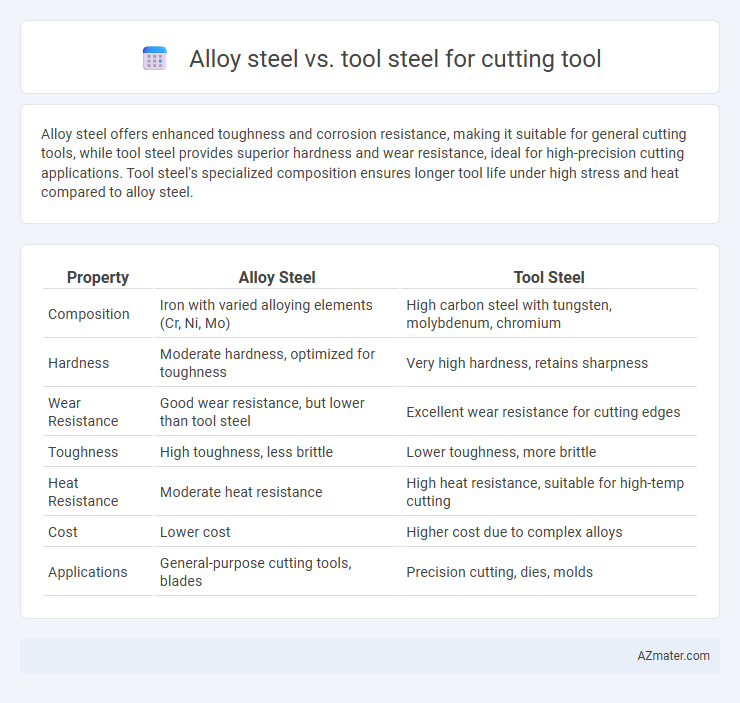Alloy steel offers enhanced toughness and corrosion resistance, making it suitable for general cutting tools, while tool steel provides superior hardness and wear resistance, ideal for high-precision cutting applications. Tool steel's specialized composition ensures longer tool life under high stress and heat compared to alloy steel.
Table of Comparison
| Property | Alloy Steel | Tool Steel |
|---|---|---|
| Composition | Iron with varied alloying elements (Cr, Ni, Mo) | High carbon steel with tungsten, molybdenum, chromium |
| Hardness | Moderate hardness, optimized for toughness | Very high hardness, retains sharpness |
| Wear Resistance | Good wear resistance, but lower than tool steel | Excellent wear resistance for cutting edges |
| Toughness | High toughness, less brittle | Lower toughness, more brittle |
| Heat Resistance | Moderate heat resistance | High heat resistance, suitable for high-temp cutting |
| Cost | Lower cost | Higher cost due to complex alloys |
| Applications | General-purpose cutting tools, blades | Precision cutting, dies, molds |
Introduction to Alloy Steel and Tool Steel
Alloy steel contains varying amounts of elements such as chromium, nickel, and molybdenum to enhance mechanical properties like toughness and strength, making it suitable for general-purpose cutting tools. Tool steel is specifically engineered with high carbon content and alloying elements like tungsten, vanadium, and cobalt to provide superior hardness, wear resistance, and heat resistance essential for precision cutting and shaping tasks. Both materials serve critical roles in cutting tool manufacturing, with alloy steel offering versatility and tool steel delivering high performance under demanding conditions.
Key Differences Between Alloy Steel and Tool Steel
Alloy steel contains various elements like chromium, nickel, and molybdenum to enhance strength and toughness, making it suitable for general-purpose cutting tools with good wear resistance. Tool steel, enriched with higher carbon content and alloying elements such as tungsten, vanadium, and cobalt, offers superior hardness, heat resistance, and edge retention essential for precise and high-performance cutting tools. The key difference lies in tool steel's enhanced wear resistance and hardness at elevated temperatures, which alloy steel cannot consistently provide under heavy-duty cutting conditions.
Composition and Properties Comparison
Alloy steel cutting tools typically contain elements like chromium, nickel, and molybdenum, enhancing toughness and wear resistance, whereas tool steel comprises higher carbon content and specific alloying elements such as tungsten, vanadium, and cobalt for superior hardness and heat resistance. Tool steel offers excellent edge retention and thermal stability at high cutting temperatures, making it ideal for precision machining and heavy-duty cutting operations. Alloy steel provides a balance of strength and ductility, making it suitable for general-purpose cutting tools with moderate wear resistance and impact toughness.
Hardness and Toughness for Cutting Tools
Alloy steel for cutting tools offers a balanced combination of hardness and toughness, making it suitable for moderate cutting applications requiring wear resistance and impact strength. Tool steel provides superior hardness and retains edge sharpness at high temperatures, essential for precision cutting and heavy-duty machining tasks. The enhanced toughness in certain tool steel grades improves resistance to chipping and deformation, optimizing tool life under extreme conditions.
Wear Resistance and Durability
Tool steel outperforms alloy steel in wear resistance due to its higher carbon content and specialized alloying elements such as tungsten, molybdenum, and vanadium that form hard carbides. The enhanced durability of tool steel makes it ideal for cutting tools subjected to high stress, abrasion, and heat, maintaining sharp edges longer under demanding machining conditions. Alloy steel, while tougher and more flexible, generally offers lower wear resistance and durability compared to the hardened microstructure of tool steel designed specifically for cutting applications.
Heat Resistance and Performance at High Temperatures
Tool steel exhibits superior heat resistance and maintains hardness at elevated temperatures, making it ideal for cutting tools operating under high thermal stress. Alloy steel, while strong and versatile, generally softens more quickly when subjected to prolonged heat, reducing its effectiveness in high-temperature cutting applications. High-speed tool steels (HSS) specifically combine elements like tungsten and molybdenum to enhance thermal stability and performance during intense cutting processes.
Cost and Availability Considerations
Alloy steel cutting tools generally offer lower initial costs and broader availability compared to tool steel, making them suitable for applications with budget constraints. Tool steel, while typically more expensive, provides superior hardness and wear resistance, justifying the investment in high-precision or heavy-duty cutting tasks. Availability of tool steel can be more limited depending on grade and supplier, potentially increasing lead times relative to the more commonly stocked alloy steel variants.
Common Applications in Cutting Tools
Alloy steel is commonly used in cutting tools for applications requiring moderate strength and toughness, such as drill bits, saw blades, and lathe tools. Tool steel, characterized by high hardness and wear resistance, is preferred for punches, dies, and cutting edges in high-stress environments like metal stamping, machining, and shaping operations. Both materials serve critical roles in manufacturing, with tool steel dominating precision cutting due to its superior performance under heat and pressure.
Maintenance and Longevity
Alloy steel cutting tools offer moderate maintenance requirements due to their balanced composition, which provides reasonable wear resistance and toughness. Tool steel, specifically designed for cutting applications, exhibits superior hardness and heat resistance, resulting in prolonged tool life and reduced frequency of sharpening or replacement. High-carbon tool steels maintain edge retention longer under high-stress conditions, minimizing downtime and maintenance costs compared to standard alloy steels.
Choosing the Right Steel for Cutting Tool Applications
Selecting the right steel for cutting tool applications depends on the specific performance requirements such as hardness, toughness, and wear resistance. Alloy steel offers good toughness and is often used for less demanding cutting tasks, while tool steel provides superior hardness and heat resistance, making it ideal for high-precision and high-temperature cutting operations. Understanding the balance between alloying elements and heat treatment processes is crucial to optimize cutting efficiency and tool longevity.

Infographic: Alloy steel vs Tool steel for Cutting tool
 azmater.com
azmater.com